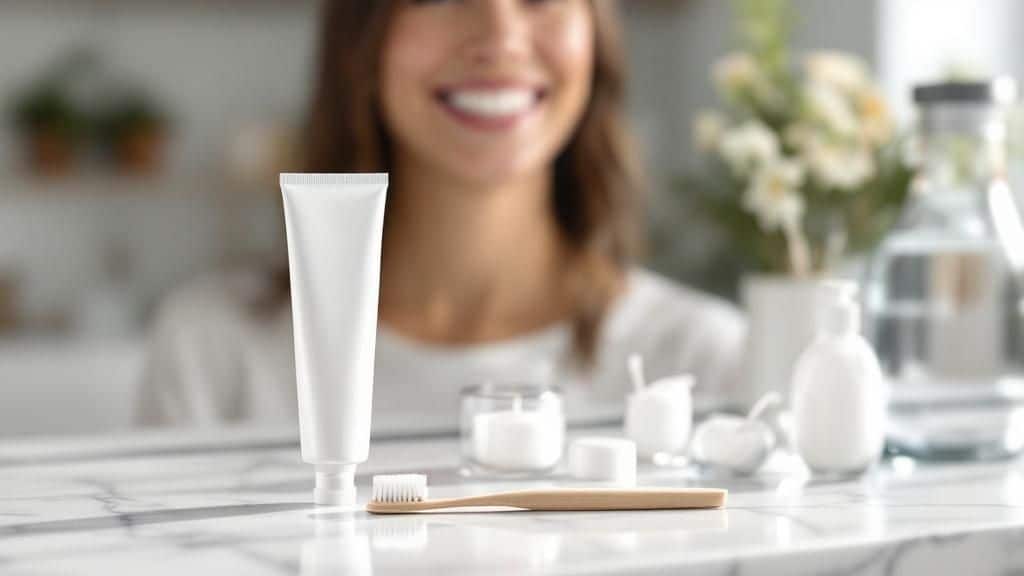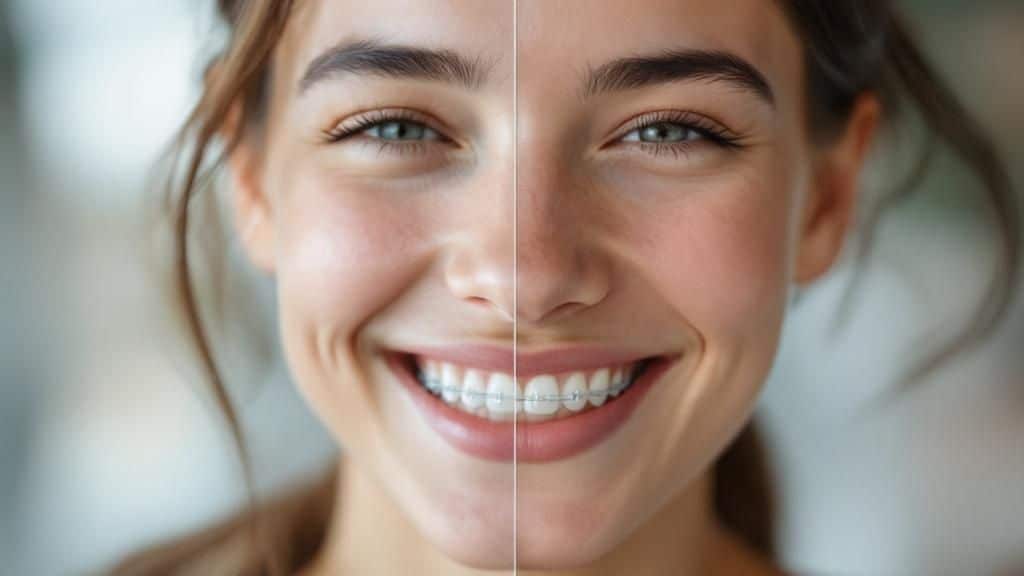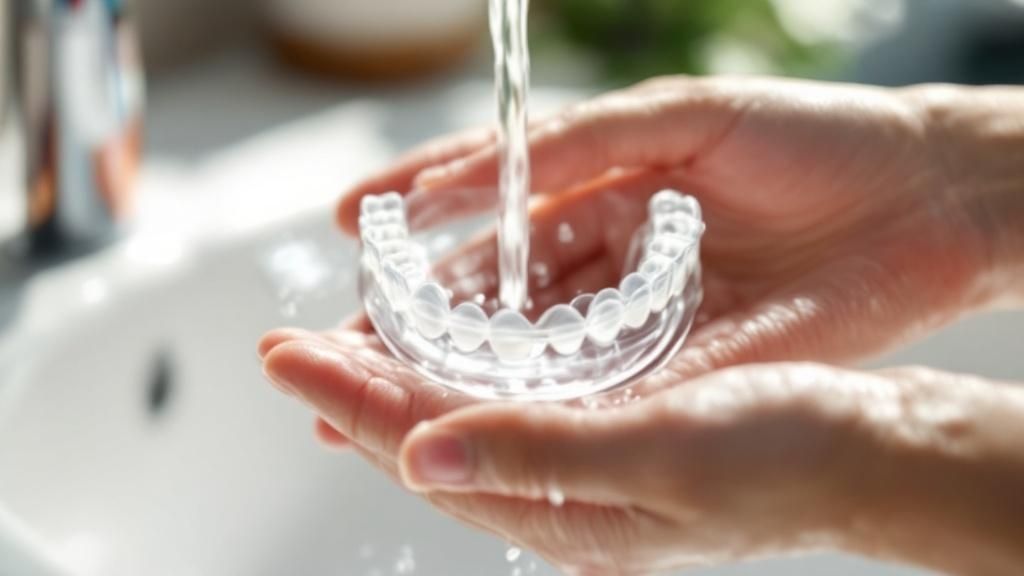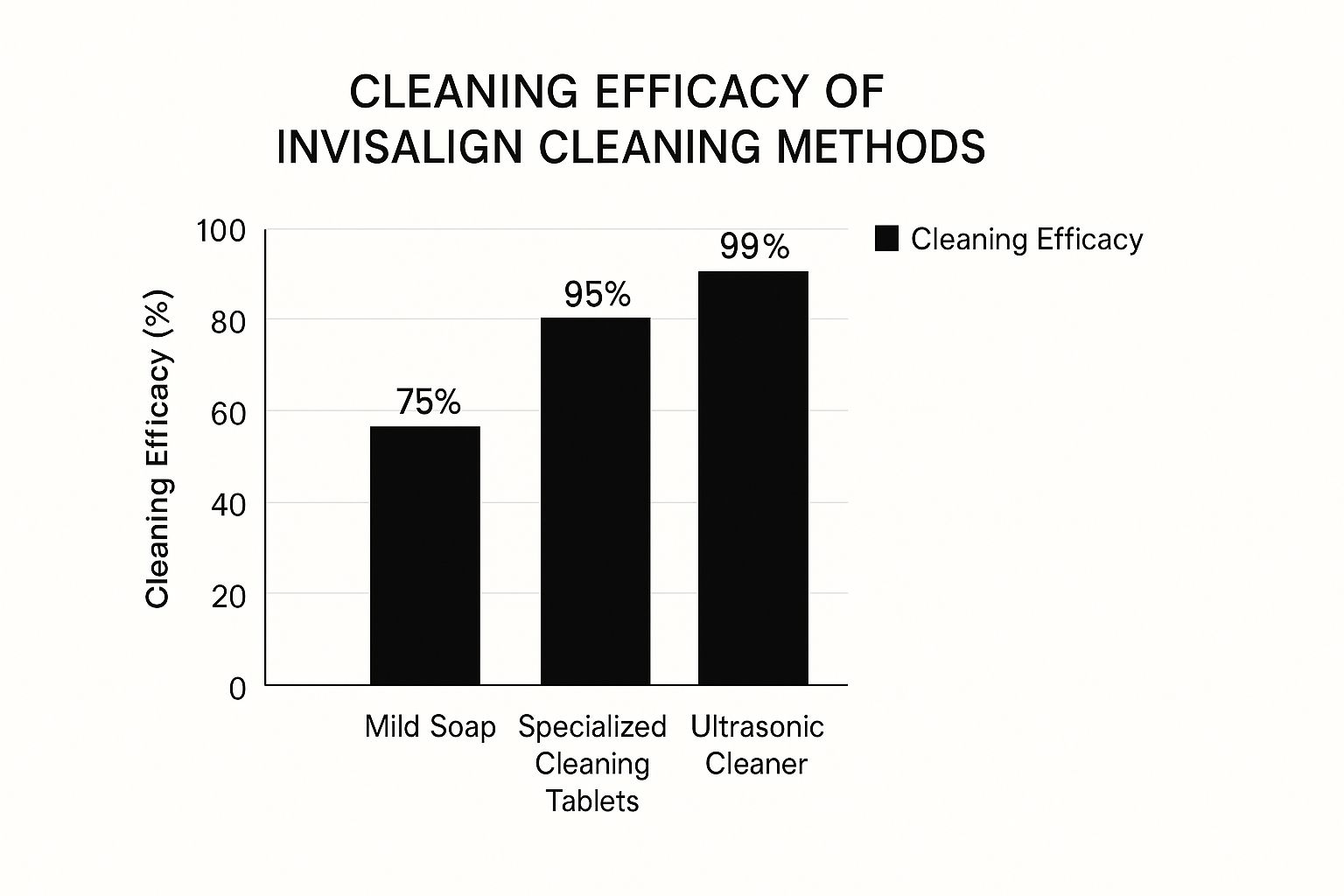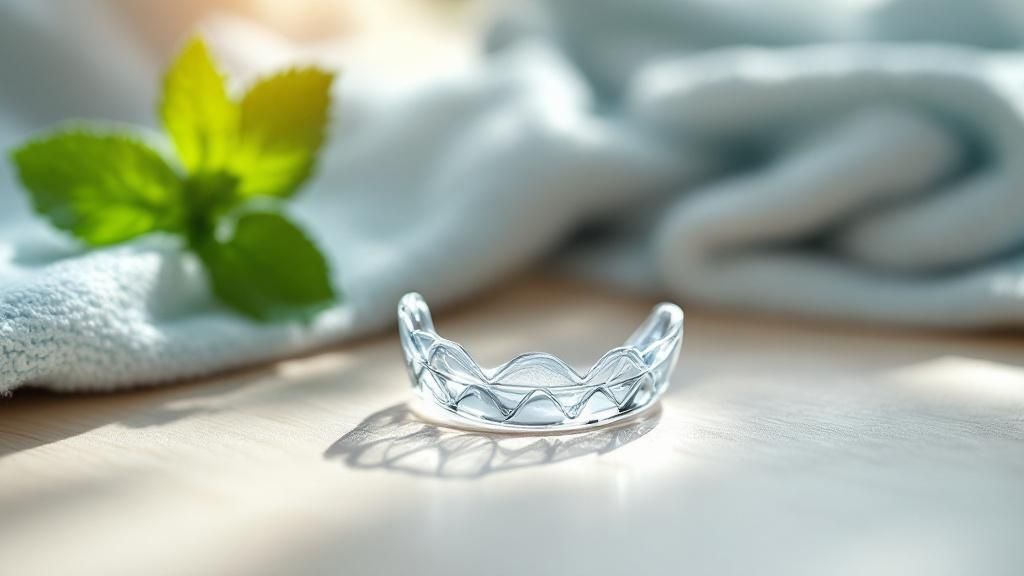How to Clean Invisalign |
Why Proper Cleaning Can Make or Break Your Invisalign Treatment
Your Invisalign aligners are an investment in a straighter smile. But just like anything valuable, they need proper care to deliver the results you expect. Overlooking aligner hygiene can seriously impact your treatment, affecting much more than just the freshness of your breath.
For instance, bacteria buildup inside your aligners can cause significant oral health issues, such as gum disease and tooth decay. Furthermore, neglecting cleaning can even reduce the aligners’ effectiveness, potentially lengthening your treatment time. Think of your aligners like a car: regular maintenance is crucial for optimal performance.
Cloudy, stained aligners aren’t just unattractive; they’re a visible sign of poor hygiene. This goes beyond mere aesthetics. In the UK, maintaining the appearance of aligners is a major concern for many undergoing orthodontic treatment. In fact, over 70% of UK orthodontic patients opt for clear aligners like Invisalign over traditional braces, underscoring the importance of keeping them clean and transparent. Find more detailed statistics here.
The Real Consequences of Poor Aligner Hygiene
Many UK orthodontists report seeing patients whose treatment progress is slowed by inadequate aligner hygiene. Some patients experience setbacks due to gum inflammation or even cavities forming beneath their aligners. You might be interested in: How to master Invisalign care. These situations highlight the critical connection between regular cleaning and successful treatment outcomes.
Additionally, failing to clean your aligners can cause unpleasant odors and a lingering bad taste. This can affect your confidence and make wearing the aligners a less enjoyable experience.
Why Your Orthodontist Emphasizes Maintenance
Your orthodontist stresses aligner maintenance because they want you to achieve the best possible results. Proper cleaning not only safeguards your oral health but also ensures your aligners function correctly to move your teeth. This means that by following a consistent cleaning routine, you’re actively contributing to the success of your treatment and protecting your investment.
Professional Products That Actually Work
Beyond general cleaning tips, several professional-grade products are specifically designed for Invisalign care in the UK. These specialized products often provide a more thorough clean and better protection compared to basic cleaning methods, safeguarding against bacteria and plaque.
Specialist Cleaning Crystals and Effervescent Tablets
Many UK orthodontists recommend specialized cleaning products. Retainer Brite, an effervescent tablet, is a popular choice. It helps eliminate bacteria and prevents plaque buildup. These tablets dissolve in water, creating a cleaning solution that effectively targets the biofilm that can accumulate on aligners. This helps maintain aligner clarity and hygiene, contributing to a more comfortable treatment experience. In fact, over 80% of UK orthodontists recommend using specialist cleaning crystals weekly. Explore this topic further.
Cleaning crystals offer another powerful cleaning option. They dissolve in water, creating a potent solution with fine particles that can reach microscopic crevices in your aligners. This removes debris that might be missed with regular brushing, promoting fresher breath and a healthier oral environment.
Choosing the Right Products for Your Needs
With the variety of professional cleaning products available in UK dental clinics and online, understanding their ingredients is essential. Some products contain specialized enzymes that break down proteins, effectively removing plaque and biofilm. Others utilize active oxygen to disinfect and deodorize, leaving aligners clean and fresh. Read also: How to choose the right cleaning product.
Cost-effectiveness is another important factor. While professional products might have a higher initial cost, their superior cleaning power can save money long-term. Preventing plaque and staining reduces the risk of aligner damage and potential treatment delays.
Sourcing Quality Cleaning Solutions in the UK
When selecting a brand, prioritize products specifically designed for orthodontic appliances. Avoid those with harsh chemicals or abrasives, as these can damage aligners. Reputable brands clearly list ingredients and provide usage instructions. Reliable sources for professional cleaning products in the UK include your orthodontist, reputable online retailers, and some pharmacies.
Look for certifications or endorsements from dental professionals as indicators of a product’s quality and effectiveness. Choosing the right professional cleaning solutions and incorporating them into your routine is a worthwhile investment in the success of your Invisalign treatment. This proactive approach helps maintain optimal aligner hygiene and keeps your smile transformation on track.
DIY Solutions That Won’t Break the Bank
Professional cleaning products are excellent, but sometimes a simple DIY approach is all you need. Many Invisalign users in the UK find success with readily available household items. This section explores these cost-effective methods using common ingredients like hydrogen peroxide and distilled vinegar.
The Science Behind Home Cleaning Solutions
Hydrogen peroxide and distilled vinegar are surprisingly effective at combating bacterial buildup. Hydrogen peroxide works as an oxidizing agent, breaking down bacteria and organic matter that lead to stains and unpleasant odours. Distilled vinegar, a mild acid, helps dissolve mineral deposits and plaque. The combined action of these two ingredients provides a thorough yet gentle clean for your aligners.
Creating Your Own Cleaning Solution
A typical home method for cleaning with hydrogen peroxide involves mixing equal parts hydrogen peroxide and water. Soak your aligners in this solution for approximately 20 minutes. A UK dental clinic survey found that over 60% of Invisalign users incorporate homemade cleaning solutions into their routine at least once a week. Learn more about simple cleaning methods here. For distilled vinegar, a solution of one part vinegar to three parts water is recommended, with a similar soaking time. You might also find this helpful: How to master Invisalign cleaning with DIY solutions. Remember to always rinse your aligners thoroughly with cool water after soaking to remove any remaining residue.
Safety and Troubleshooting Tips
While generally safe, incorrect use of these DIY methods can damage your aligners. Using incorrect mixing ratios or soaking for too long can lead to warping or discolouration. Adhere to the recommended dilutions and soak times. If you find your cleaning solution isn’t as effective as expected, check the expiration date of your hydrogen peroxide, as it can lose potency over time. Brushing your aligners gently with a soft-bristled toothbrush before and after soaking is also recommended for optimal cleaning.
What to Avoid
Never use hot water when cleaning your aligners, as this can warp the plastic. Avoid abrasive cleaners, harsh chemicals, and coloured mouthwash, which can scratch, discolour, or damage the aligner material. Sticking to the recommended methods will keep your aligners clean, potentially extending their lifespan and contributing to a smoother Invisalign experience.
Building a Routine That Actually Sticks
Creating a successful cleaning routine for your Invisalign aligners isn’t about achieving perfection. It’s about establishing a system you can realistically maintain over time. Integrating aligner care into your daily life shouldn’t feel like a burden, whether you’re commuting or relaxing at home. This section provides practical guidance on developing a cleaning routine that complements your current oral hygiene practices.
Practical Morning and Evening Protocols
The simplest way to start is by linking aligner cleaning with habits you already have. For instance, clean your aligners every time you brush your teeth. This connection makes it easier to remember and incorporate into your daily schedule. Each morning, after brushing, clean your aligners before putting them back in. In the evening, follow the same process: remove your aligners, brush your teeth, and then clean your aligners before soaking them overnight. Exploring cost-effective design solutions can be helpful when selecting cleaning options.
Staying on Track When Life Gets Busy
Modern life, especially in the UK, is often fast-paced. Travel, social events, and unexpected changes to your schedule can disrupt even the most well-intentioned routines. Portable cleaning solutions, such as travel-sized brushes and small containers for soaking solution, can help maintain your aligner hygiene on the go. For additional tips, take a look at our article on How to Master a Cleaning Routine. Having a spare set of aligners and a small cleaning kit in your bag is also a smart strategy for handling unexpected situations.
Overcoming Common Challenges
Many people cite lack of time as a significant hurdle. However, cleaning your aligners only requires a few minutes. Consider it a small investment in the health and appearance of your future smile. If forgetfulness is an issue, set reminders on your phone or keep your cleaning supplies in a highly visible spot. Finally, when convenience tempts you to skip a cleaning, remember the potential downsides: bad breath, staining, and even delays in your treatment progress.
By taking a practical approach, connecting cleaning to existing habits, and planning for busy days, you can build a sustainable cleaning routine that will last throughout your Invisalign journey. Learning from others’ successes can be incredibly valuable. Their strategies for maintaining motivation are powerful resources for achieving long-term results.
Which Methods Really Deliver Results
With so many Invisalign cleaning methods available, finding the right one can be daunting. This section helps clarify which techniques are truly effective, offering comparisons of various approaches, from simple rinsing to ultrasonic cleaning. We’ll examine how each method performs in removing bacteria, maintaining clarity, and preserving the aligner’s integrity.
Comparing Cleaning Methods: A Data-Driven Approach
The success of your Invisalign treatment depends heavily on the effectiveness of your cleaning routine. Different methods produce different results, and understanding these nuances is key. Let’s explore the efficacy of three common approaches:
This infographic shows the cleaning effectiveness of mild soap (75%), specialized cleaning tablets (95%), and ultrasonic cleaners (99%). While mild soap offers some cleaning power, specialized tablets and ultrasonic cleaners are significantly better at removing bacteria and maintaining clarity. Investing in these methods can lead to better oral hygiene and treatment outcomes. A study further emphasizes this point, demonstrating that rinsing alone is far less effective than methods like ultrasonication with a cationic detergent solution. Read the full research here.
To help illustrate the differences between these and other cleaning methods, we’ve compiled the following comparison table:
Invisalign Cleaning Methods Effectiveness Comparison
| Cleaning Method | Effectiveness Rating | Cost Level | Time Required | Recommended Frequency |
|---|---|---|---|---|
| Rinsing with Water | Low | Very Low | Minimal | After each removal |
| Mild Soap and Water | Moderate | Low | Low | Daily |
| Specialized Cleaning Tablets | High | Moderate | Low | Daily |
| Ultrasonic Cleaner | Very High | High | Moderate | Weekly |
| Hydrogen Peroxide Soak (3%) | Moderate | Low | Moderate | Weekly (with caution) |
As you can see, each cleaning method represents a different balance of effectiveness, cost, and time commitment. Choosing the right approach depends on individual needs and preferences.
Cost-Benefit Analysis: Finding the Right Balance
Choosing an Invisalign cleaning method requires balancing cost, convenience, and effectiveness. While some methods might seem inexpensive, their lower effectiveness could lead to problems later, potentially necessitating replacements or extending treatment. This is especially important for patients at Smileology Dental Practice in Maidstone and Rochester, where optimal outcomes are paramount. For related information, you can explore the Superdocu Blog.
Combining Methods For Comprehensive Cleaning
Combining cleaning methods can be very effective. Using specialized cleaning tablets daily, combined with a weekly ultrasonic cleaning, offers a robust approach to aligner hygiene. This ensures thorough cleaning and helps remove stubborn stains. For tailored advice, see our guide on Invisalign cleaning for busy individuals. Remember, your cleaning needs may evolve throughout treatment, so adapting your routine is essential.
Adapting Your Approach To Your Lifestyle
The ideal cleaning method is one that integrates seamlessly into your life. Whether you’re a busy professional or a student, finding a cleaning routine that suits your schedule and budget will help you maintain aligner hygiene and ensure the best results from your Invisalign treatment.
Avoiding Mistakes That Damage Your Investment
Some cleaning mistakes have instantly visible consequences for your Invisalign aligners. Others gradually cause damage without any noticeable signs until it’s too late. This section focuses on the most frequent errors that can warp, scratch, or weaken your aligners, starting with seemingly harmless practices that often cause the most damage.
The Dangers of Hot Water and Harsh Chemicals
One of the biggest culprits in aligner damage is hot water. Exposing your aligners to high temperatures can warp the plastic. This affects their fit and potentially hinders your treatment progress. Think of it like leaving a plastic bottle in a hot car – it loses its original shape. Similarly, hot water can permanently alter the precise shape of your aligners, rendering them ineffective.
Another common mistake is using the wrong cleaning products, such as household cleaners or abrasive toothpaste. These products often contain harsh chemicals that can scratch or dull the aligner surface. This not only makes them look less appealing but can also create microscopic crevices where bacteria can thrive.
Recognizing the Warning Signs
Early detection of cleaning-related issues is crucial for your Invisalign treatment. Changes in aligner fit, such as feeling tighter or looser than usual, can indicate warping. Visible scratches or cloudiness also signal potential damage. If you notice any of these signs, consult your orthodontist.
Safe Alternatives and Best Practices
Instead of hot water, always use lukewarm or cool water for cleaning and rinsing your aligners. Opt for specialized cleaning products recommended by your orthodontist, such as Retainer Brite or cleaning crystals. You can also use gentle DIY solutions like a hydrogen peroxide soak.
Avoid using anything abrasive on your aligners, including hard-bristled toothbrushes. Gentle cleaning is key to maintaining their integrity and ensuring your treatment stays on track.
By understanding these common pitfalls and adopting preventative measures, you can protect your investment in Invisalign. Proper care not only maximizes the effectiveness of your aligners, but also contributes to better overall oral hygiene throughout your treatment. This will help ensure your treatment progresses smoothly toward achieving that perfect smile.
Expert Strategies for Long-Term Success
Maintaining excellent Invisalign hygiene throughout your treatment is crucial for achieving the best results. This section explores advanced strategies, recommended by UK orthodontic professionals, to address common challenges and ensure long-term success with your aligners.
Handling Stubborn Stains and Persistent Odours
Even with regular cleaning, stubborn stains or lingering odours can occasionally appear on your aligners. Soaking them in a solution of one part hydrogen peroxide to three parts water for 30 minutes can effectively lift discolouration and neutralize odours. Remember to rinse the aligners thoroughly afterward. For particularly resistant stains, consider using specialized cleaning crystals designed for orthodontic appliances. These often contain active oxygen, which breaks down stains without harming the aligner material.
Emergency Cleaning Scenarios
Sometimes, you might need to clean your aligners without access to your regular cleaning supplies. In these situations, rinsing them thoroughly with bottled water and gently brushing with a soft-bristled travel toothbrush can help remove food particles and maintain hygiene until you can perform a more comprehensive cleaning.
Advanced Storage Solutions
Proper storage is as vital as cleaning. Always store your aligners in their protective case when not in use to prevent damage and contamination. This also helps avoid misplacing them. Consider investing in a UV sanitizing case, which utilizes ultraviolet light to eliminate bacteria and further enhance hygiene.
Aligner Care Throughout Your Treatment Journey
Your cleaning needs may change as your treatment progresses. As your teeth shift, certain areas might become more susceptible to trapping food particles. Seasonal changes can also influence your cleaning routine. During warmer months, bacteria can multiply faster, requiring extra attention to hygiene.
Troubleshooting and Professional Consultation
If you experience persistent issues such as recurring stains, odours, or discomfort, consult your orthodontist. Some problems may require professional intervention, while others can be resolved with adjustments to your home care routine.
To help you navigate the various cleaning product options available in the UK, we’ve compiled the following table:
UK Invisalign Cleaning Products and Availability
Overview of professional cleaning products available in the UK, including where to buy them and approximate costs
| Product Name | Type | Where to Buy | Approximate Cost | Treatment Duration |
|---|---|---|---|---|
| Invisalign Cleaning Crystals | Cleaning Solution | Boots, Superdrug, Online Retailers | £10-£15 | Not Applicable |
| Retainer Brite Tablets | Cleaning Solution | Amazon, Online Retailers | £5-£10 | Not Applicable |
| Steraligner Cleaning Solution | Cleaning Solution | Dental Practices, Online Retailers | £15-£20 | Not Applicable |
| Hydrogen Peroxide (3%) | Cleaning Solution | Pharmacies, Supermarkets | £1-£2 | Not Applicable |
| UV Sanitizing Case | Sanitizing Device | Amazon, Online Retailers | £20-£40 | Not Applicable |
This table provides a general overview and prices may vary. Always consult your orthodontist for recommendations specific to your needs.
By understanding the various products available and their associated costs, you can make informed decisions about your aligner hygiene routine.
A comprehensive approach to Invisalign care, incorporating these expert strategies, is essential for successful treatment. By adopting these practices, you are investing in achieving the confident, healthy smile you deserve.
Ready to start your journey towards a straighter smile? Contact Smileology Dental Practice in Maidstone and Rochester today to schedule your Invisalign consultation.



